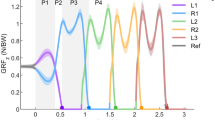Abstract
Gait analysis is commonly addressed through inverse dynamics. However, forward dynamics can be advantageous when descending to muscular level, as it allows activation and contraction equations to be integrated with motion thus providing better dynamic consistency, or when studying assisted gait, as it enables the estimation of the interaction forces between subject and devices even if the motion capture process doesn’t provide enough resolution to distinguish the motions of limb and device. Control-based methods seem to be the most natural choice to carry out the forward-dynamics analysis of an acquired gait, but several options exist in their application. The paper explores such options for healthy and assisted gait, and concludes that the computed torque control of all the subject’s degrees of freedom is the alternative that provides the most accurate results. Moreover, the study of its more problematic underactuated variant accompanied by contact models showed to be connected to neighbor challenging topics as gait prediction or walking simulation of humanoids.


























Similar content being viewed by others
References
Winter, D.A.: Biomechanics and Motor Control of Human Movement, 3rd edn. Wiley, New York (2005)
Abdel-Malek, K.A., Arora, J.S.: Human Motion Simulation. Academic Press, San Diego (2013)
Riemer, R., Hsiao-Wecksler, E.T.: Improving net joint torque calculations through a two-step optimization method for estimating body segment parameters. J. Biomech. Eng. 131(1), 011007 (2009)
Holmberg, L.J., Klarbring, A.: Muscle decomposition and recruitment criteria influence muscle force estimates. Multibody Syst. Dyn. 28(3), 283–289 (2012)
Thelen, D.G., Anderson, F.C.: Using computed muscle control to generate forward dynamic simulations of human walking from experimental data. J. Biomech. 39, 1107–1115 (2006)
Michaud, F., Lugris, U., Ou, Y., Cuadrado, J., Kecskemethy, A.: Influence of muscle recruitment criteria on joint reaction forces during human gait. In: ECCOMAS Thematic Conference on Multibody Dynamics, Barcelona, Spain (2015)
Quental, C., Folgado, J., Ambrosio, J.: A window moving inverse dynamics optimization for biomechanics of motion. Multibody Syst. Dyn. 38(2), 157–171 (2016)
Quental, C., Azevedo, M., Ambrosio, J., Gonçalves, S.B., Folgado, J.: Influence of the musculotendon dynamics on the muscle force sharing problem of the shoulder: a fully inverse dynamics approach. J. Biomed. Eng. 140(7), 071005 (2018)
Ackermann, M., Schiehlen, W.: Physiological methods to solve the force-sharing problem in biomechanics. In: Bottasso, C.L. (ed.) Multibody Dynamics—Computational Methods and Applications, pp. 1–24. Springer, Berlin (2009)
Silva, P.C., Silva, M.T., Martins, J.M.: Evaluation of the contact forces developed in the lower limb/orthosis interface for comfort design. Multibody Syst. Dyn. 24(3), 367–388 (2010)
Dallali, H., Mosadeghzad, M., Medrano-Cerda, G.A., Docquier, N., Kormushev, P., Tsagarakis, N., Li, Z., Caldwell, D.: Development of a dynamic simulator for a compliant humanoid robot based on a symbolic multibody approach. In: IEEE Int. Conference on Mechatronics, ICM, Vicenza, Italy (2013)
Ackermann, M., van den Bogert, A.J.: Optimality principles for model-based prediction of human gait. J. Biomech. 43(6), 1055–1060 (2010)
Vaughan, C.L., Davis, B.L., O’Connor, J.C.: Dynamics of Human Gait, 2nd edn. Kiboho Publishers, Cape Town (1999)
Ambrosio, J.A.C., Kecskemethy, A.: Multibody dynamics of biomechanical models for human motion via optimization. In: Garcia Orden, J.C., Goicolea, J.M., Cuadrado, J. (eds.) Multibody Dynamics—Computational Methods and Applications, pp. 245–270. Springer, Berlin (2007)
Lugris, U., Carlin, J., Luaces, A., Cuadrado, J.: Gait analysis system for spinal cord injured subjects assisted by active orthoses and crutches. J. Multi-Body Dyn. 227(4), 363–374 (2013)
https://www.iftomm-multibody.org/benchmark/, Library of Computational Benchmark Problems (problem Gait 2D)
Garcia de Jalon, J., Bayo, E.: Kinematic and Dynamic Simulation of Multibody Systems. Springer, New York (1994)
Gupta, K.C.: Mechanics and Control of Robots. Springer, New York (1997)
Seifried, R.: Integrated mechanical and control design of underactuated multibody systems. Nonlinear Dyn. 67, 1539–1557 (2012)
Blajer, W.: The use of servo-constraints in the inverse dynamics analysis of underactuated multibody systems. J. Comput. Nonlinear Dyn. 9(4), 041008 (2014)
Seth, A., Pandy, M.G.: A neuromusculoskeletal tracking method for estimating individual muscle forces in human movement. J. Biomech. 40, 356–366 (2007)
Lugris, U., Carlin, J., Pamies-Vila, R., Font-Llagunes, J.M., Cuadrado, J.: Solution methods for the double-support indeterminacy in human gait. Multibody Syst. Dyn. 30(3), 247–263 (2013)
Shourijeh, M.S., McPhee, J.: Foot–ground contact modeling within human gait simulations: from Kelvin–Voigt to hyper-volumetric models. Multibody Syst. Dyn. 35(4), 393–407 (2015)
Hansen, N.: The CMA evolution strategy: a comparing review. Stud. Fuzziness Soft Comput. 192, 75–102 (2006)
Dopico, D., Luaces, A., Gonzalez, M., Cuadrado, J.: Dealing with multiple contacts in a human-in-the-loop application. Multibody Syst. Dyn. 25(2), 167–183 (2011)
Flores, P., Machado, M., Silva, M.T., Martins, J.M.: On the continuous contact force model for soft materials in multibody dynamics. Multibody Syst. Dyn. 25(3), 357–375 (2011)
Englsberger, J., Ott, C., Albu-Schäffer, A.: Three-dimensional bipedal walking control based on divergent component of motion. IEEE Trans. Robot. 31(2), 355–368 (2015)
Dehghani, R., Fattah, A., Abedi, E.: Cyclic gait planning and control of a five-link biped robot with four actuators during single support and double support phases. Multibody Syst. Dyn. 33(4), 389–411 (2015)
Wang, J.M., Hamner, S.R., Delp, S.L., Koltun, V.: Optimizing locomotion controllers using biologically-based actuators and objectives. ACM Trans. Graph. 31(4), 25 (2012)
Geijtenbeek, T., van de Panne, M., van der Stappen, A.F.: Flexible muscle-based locomotion for bipedal creatures. ACM Trans. Graph. 32(6), 206 (2013)
Compliance with Ethical Standards
Research involving human participants: This study was approved by the institutional ethical committee.
Informed consent: All participants in the experiments gave their informed consent.
Funding: This study was funded by the Spanish Ministry of Economy and Competitiveness (MINECO) under project DPI2015-65959-C3-1-R, cofinanced by the European Union through EFRD program.
Conflict of interest: J. Cuadrado is a member of the Editorial Board of the journal Multibody System Dynamics. The remaining authors have no conflict of interest.
Author information
Authors and Affiliations
Corresponding author
Additional information
Publisher’s Note
Springer Nature remains neutral with regard to jurisdictional claims in published maps and institutional affiliations.
Rights and permissions
About this article
Cite this article
Mouzo, F., Lugris, U., Pamies-Vila, R. et al. Skeletal-level control-based forward dynamic analysis of acquired healthy and assisted gait motion. Multibody Syst Dyn 44, 1–29 (2018). https://doi.org/10.1007/s11044-018-09634-4
Received:
Accepted:
Published:
Issue Date:
DOI: https://doi.org/10.1007/s11044-018-09634-4




